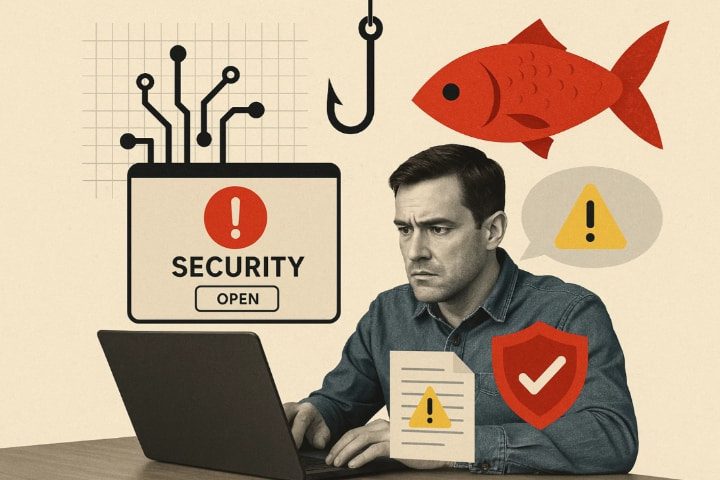Spear phishing is the most dangerous cyber threat in 2025. In comparison to traditional phishing, spear phishing involves the application of knowledge-based details about a victim to create personalized messages. With more and more sophisticated and frequent occurrence of such attacks, it is important to realize spear phishing for all, including individuals and organizations. This guide will be dedicated to the threats posed by spear phishing, its mechanism, detection, and recovery and prevention tactics.
What is spear phishing?
Spear phishing is a focused cyber attack that involves the use of personalized emails in order to fool targeted victims. Attackers collect extensive information about the target through the social media accounts, the company websites or any other online platforms. Using this information, they develop emails that seem to be the email of individuals or organizations they trust.



The emails frequently request the recipients of the emails to supply confidential information, including passwords or financial data, or advise them to follow malicious links or to download malicious attachments. This is unlike the broad phishing, which relays generic messages to a large number of individuals in the hope that some end up becoming victims. The customization of Spear phishing makes it more convincing and deceitful that even skeptical users are sometimes deceived.
Use parental controls to protect your kids from online scams.
Why is spear phishing so risky?
Spear phishing is a susceptible vice, mainly because it is personalized and misleading. To create persuasive messages, the attackers will study their victims and thus they have high chances of making the victims believe the communication.
The level of success is higher than a generic phishing effort because this is a targeted attack. Spear phishing may have dire consequences such as financial damages, identity theft, data breach and reputation damage. The people and organizations are the most common victims. In the case of businesses, attacks have been known to cause expensive data breaches, regulatory penalties and disruptions of business.
Research indicates that executives, finance departments and IT personnel are often the targets due to their available access to valuable resources. As it is reported, phishing-based attacks are considered as a cause of more than 36 percent of all data breaches worldwide, and spear phishing is a prominent one. Victims also experience emotional and psychological stress which makes it hard to recover.
Spear phishing vs. other online scams
Spear phishing has a niche amongst the other online scams. It is very personalized in luring victims unlike most general scams. In order to comprehend the peculiarities of spear phishing, it is better to compare it with the similar scams:
Spear phishing vs. phishing
The phishing that is traditional involves sending mass emails with generic contents to a large group of people. These emails make general assertions or threats in order to elicit action to anyone. Spear phishing specifically targets individuals or groups. From this, attackers will customize their messages with some valuable information that builds trust like naming a colleague or recent business transaction. This accuracy adds to its possibility of attracting the attention of the victim and making them take action.
Spear phishing vs. whaling phishing
Whaling is a particular example of spear phishing that is aimed at high-profile people, including CEOs or senior executives. These attacks are generally more advanced, and these are based on a request of high-level authority. The economic interests are greater as whaling usually tries to approve substantial financial transactions or secret business resolutions. Whaling, in short, is spear phishing but with a limited scope on the top management.
Spear phishing vs. smishing and vishing
Smishing and vishing are phishing through other mediums of communication. Smishing involves deception of the victims via text messages or SMS. Vishing involves phone calls, which are usually pre-recorded or live voices that pretend to be such as genuine phone callers. The two are also focused on acquiring sensitive information and do not rely on the email as much as spear phishing. Nonetheless, they are all social engineering tricks that take advantage of trust and urgency despite the difference in communication.
How does spear phishing work?
A spear phishing attacks have a lifecycle that consists of a number of steps:
Reconnaissance
- Hackers do a lot of research to gather personal and professional information regarding the target. They access through social media, public databases, data breaches and company websites.
Target selection
- Attackers choose people with valuable access or information based on the details obtained. They usually target finance employees, executives and IT staff.
Crafting the email
- The attacker develops extremely personalized spear phishing email which appears to be a normal conversation. Attackers use references to projects, known contacts, or company jargon to appear credible.
Email delivery
- Once the spam letter is spear phished, it may be sent at the time of an ongoing business event to enhance the degree of believability.
Victim interaction
- The email is sent to the victim. Victims click malicious links, open infected attachments, or submit credentials when deceived.
Exploitation and follow-up
- With stolen access or information, attackers can further their intrusion, steal data or commit financial fraud. They can make additional attacks with the weakened account.
Common techniques and tactics spear phishing scammer use
Spear phishing fraudsters use advanced techniques to increase success. Common techniques include:
- Email spoofing: It is a trick of making emails look like they have been sent by reliable sources by using forged addresses of senders.
- Social engineering: This involves taking advantage of reputation through use of personal or organization information during emails.
- Urgency and pressure: Inventing emergencies that are not really there in order to make the target do things without considering the consequences.
- Malicious attachments: Malicious attachments disguise infected files as authentic ones.
- Redirection by links: Attaching malicious links under apparently harmless links.
- Email thread hijacking: People add bogus responses to an existing conversation to use trust and connections established in the conversation.
- AI deepfake content: Fraudsters use AI deepfakes to mimic familiar voices or images.
- Cross-platform impersonation: Personalized scam messages with the help of social media and chat applications.
Such tricks take advantage of human psychology, existing technologies, and thorough research of victims and spear phishing is hard to identify.
How to identify spear phishing attempts?
- Users detect spear phishing by noticing minor inconsistencies and red flags. One of the indicators is the email address of the sender. In many cases, it is a little bit different than trusted contacts, containing misspellings or weird domain names.
- Confidential information or money transfer requests which are out of the blue should sound an alarm. Real organizations hardly request sensitive information via email. Likewise, Users should investigate emails that pressure urgency or deadlines. The email contains personal information that, when used incorrectly or out of context, may be an indication of fraud. Bad grammar, clumsy wording or strangeness in word use are also more indicators to look.
- Never click on anything without hovering on it first. In case the URL is suspicious or unrelated with the sender, do not interact. It is important that the content of the emails is consistent with the prior communication. It is most likely that messages which are out of character or irrelevant to your job are indicative of a scam. To ensure that there is authenticity, verifying the unusual request using other channels such as by calling the suspect or sending a separate message to the alleged sender is a sure fire method.
What to do If you fall victim to spear phishing?
When a spear phishing attack is successful, a response in time is a way of minimizing the damage. Do not touch the suspicious email anymore. Do not follow any more links or attachments.
- Immediately report the same to the IT or security team of the organization you work in. Early detection prevents larger damage. Users should change passwords on a trusted device, not on a compromised one.
- Users should enable multi-factor authentication on important accounts to block unauthorized access. Inspect financial accounts and credit reports to identify any suspicious activity and notify financial institutions of any suspicion.
- Think of the services of cybersecurity specialists to ask and help to restore hacked accounts or devices. In case the systems in question are work related, inform your colleagues to curb the spread of the attack.
How to protect yourself and your family from spear phishing?
Protection is a combination of technological safety and education. Learn about the latest tricks of phishing and remain aware of the tricks. Users should create strong, unique passwords for each account and update them regularly.
- Add a necessary layer of security in the form of multi-factor authentication wherever possible. Always update your operating systems, browsers and security programs to seal the loopholes.
- Restrict the dissemination of personal and professional data on social media and other social sites. This data is usually used by attackers to make personal attacks.
- Do not follow unwanted links and do not download anything dubious. Save valuable information on a regular basis to protect against ransomware attacks or loss.
Instruct the family members on the risks and warning signs of spear phishing. In case of families having kids, apply parental control programs such as Flashget Kids. This application tracks the content and blocks suspicious or malicious websites in real time. All this, keeps the minors out of phishing scams and other threats via the internet.



Educate all members of your home on the best practices in relation to cybersecurity and develop a culture of alertness and protection.
Wrap up
Spear phishing is a more advanced and serious cyber threat in 2025. With a well-planned attack, these attacks are taking advantage of trust as the people receive messages that are personalized to them. The impacts include loss of money as well as sensitive information and emotional anguish.
Awareness is the strongest defense against spear phishing. The ability to spot suspicious emails, knowledge on attacker techniques, and know how to react swiftly reduces casualties. The best protection occurs with vigilant behavior coupled with powerful security measures such as multi-factor authentication and latest software.
Families also have to take initiatives. Parents can use tools like FlashGet Kids to protect children from harmful content and fraud. Finally, training and education make all people able to counter such false attacks and be digitally safe.
FAQs
A hacker pretends to be a company CEO and sends an email to a financial employee, informing him that he needs to transfer money urgently to a suspicious account.
Look at sender addresses, urgent or suspicious requests, suspicious links and confirm the request by using a different method of communication.

